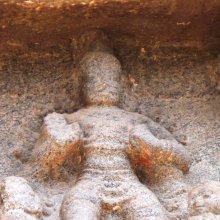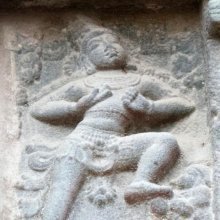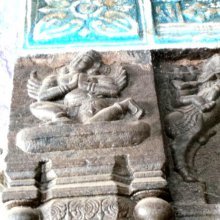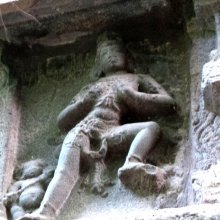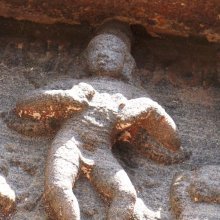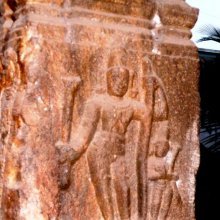Ancita, Añcita, Amcita: 17 definitions
Introduction:
Ancita means something in Hinduism, Sanskrit, Marathi. If you want to know the exact meaning, history, etymology or English translation of this term then check out the descriptions on this page. Add your comment or reference to a book if you want to contribute to this summary article.
Alternative spellings of this word include Anchita.
Images (photo gallery)
(+89 more images available)
In Hinduism
Natyashastra (theatrics and dramaturgy)
Source: Wisdom Library: Nāṭya-śāstra1) Añcita (अञ्चित).—One of the 108 karaṇas (minor dance movement) mentioned in the Nāṭyaśāstra chapter 4. The instructions for this añcita-karaṇa is as follows, “in the Ardhasvastika the Karihasta to be alternately in Vyavartita (Vyavṛttā) and Parivartita movement, and then bent upon the tip of the nose”. A karaṇa represents a minor dance movements and combines sthāna (standing position), cārī (foot and leg movement) and nṛttahasta (hands in dancing position).
2) Añcita also refers to specific ‘movement of the head’ (śiras), according to the Nāṭyaśāstra chapter 8. The head is one of the six major limbs (aṅga) used to perform certain gestures (āṅgika). These gestures form a part of the histrionic representation (abhinaya). Instructions: “when the neck is slightly bent on one side the añcita head is the result”. Uses: “it is applicable in sickness, swoon, intoxication anxiety and sorrow”.
3) Añcita (अञ्चित, “arched”) refers to a specific gesture (āṅgika) made with the neck (grīvā), according to the Nāṭyaśāstra chapter 8. These ‘gestures of the neck (grīvā)’ should follow the gestures made with the head (śiras). These gestures form a part of the histrionic representation (abhinaya). Instructions: “the neck with the head turned back”. Uses: “in hanging to death, arranging hair and looking very high up”.
4) Añcita (अञ्चित) refers to a specific gesture (āṅgika) , or “movements made with the arms (bāhu)”, according to the Nāṭyaśāstra chapter 9. These movements form a part of the histrionic representation (abhinaya).
3) Añcita (अञ्चित) refers to a specific ‘movement of the feet’ (pāda), according to the Nāṭyaśāstra chapter 10. The feet are one of the six major limbs (aṅga) used to perform certain gestures (āṅgika). These gestures form a part of the histrionic representation (abhinaya). Instructions: “the heels on the ground, the forepart of the feet raised and all the toes spread. Uses: “it is to be applied in representing a movement with wound at the forepart of the foot, turning round in every way, foot being struck by something and in various Bhramarī movements”.
Source: Wisdom Library: SaṅgītaśiromaṇiAñcita (अञ्चित, “bent”) refers to “honorific” and is one of the sixteen words that together make up the elā musical composition (prabandha), according to the Saṅgītaśiromaṇi 67-84. Elā is an important subgenre of song and was regarded as an auspicious and important prabandha (composition) in ancient Indian music (gāndharva). According to nirukta analysis, the etymological meaning of elā can be explained as follows: a represents Viṣṇu, i represents Kāmadeva, la represents Lakṣmī.
Añcita is one of the sixteen words of elā and has a presiding deity named vāṇī (=Sarasvatī, ‘speech’) defined in the Saṅgītaśiromaṇi (“crest-jewel of music”), which is a 15th-century Sanskrit work on Indian musicology (gāndharvaśāstra).
Source: archive.org: The mirror of gesture (abhinaya-darpana)One of the Twenty-four Heads. Añcita (bent): the neck is slightly bent to one side. Usage: regarding anything vile, being in love, fainting, etc., gazing at the middle of the lower lip.
Source: Shodhganga: The significance of the mūla-beras (natya)Añcita means to “lift, standing on the hind heels” and represents one of five actions of the foot used in kūttu (dance) as defined in the first book of the Pañcamarapu (‘five-fold traditional usage’) which deals with niruttam (dance, one of the sixty–four arts) and represents an important piece of Tamil literature.—The Pañcamarapu (“five-fold traditional usage”) refers to a book on five established literary usages (five-fold traditional usages) defines terms such as Añcita. It was composed by Cerai Aṟivanār in the 9th century AD during the time of Pandyan Tirumaran of the last Caṅkam Period.
Source: Shodhganga: Elements of Art and Architecture in the Trtiyakhanda of the Visnudharmottarapurana (natya)Añcita (अञ्चित) refers to one of the thirty Nṛttahastas or “dance hand gestures” (in Indian Dramas), according to the Viṣṇudharmottarapurāṇa, an ancient Sanskrit text which (being encyclopedic in nature) deals with a variety of cultural topics such as arts, architecture, music, grammar and astronomy.—The hasta-mudrās (lit. “hand-gestures”) are very essential to denote some particular action or state in dancing and these mudrās are formed with the help of hands and fingers. In the Viṣṇudharmottarapurāṇa, thirty kinds of nṛttahastas (“dance-hand gestures”) are mentioned. e.g., añcita. The practice of these nṛttahastas is strictly prohibited in sickness of body, in old age, in fear, drunk and anxiety.

Natyashastra (नाट्यशास्त्र, nāṭyaśāstra) refers to both the ancient Indian tradition (shastra) of performing arts, (natya—theatrics, drama, dance, music), as well as the name of a Sanskrit work dealing with these subjects. It also teaches the rules for composing Dramatic plays (nataka), construction and performance of Theater, and Poetic works (kavya).
Shaivism (Shaiva philosophy)
Source: Brill: Śaivism and the Tantric TraditionsAñcita (अञ्चित) refers to “embellished (with anklets)”, according to the 13th-century Matsyendrasaṃhitā: a Kubjikā-Tripurā oriented Tantric Yoga text of the Ṣaḍanvayaśāmbhava tradition from South India.—Accordingly, “[Visualisation of Śakti]:—[...] She is anointed with divine ointments and she is dressed in divine clothes, with her loins exposed. Her thighs and shanks are beautiful. Her body is the ultimate essence of gracefulness. Her feet are embellished with anklets (mañjīra-añcita). She wears divine garlands and [has been anointed] with divine ointments. [...]”.

Shaiva (शैव, śaiva) or Shaivism (śaivism) represents a tradition of Hinduism worshiping Shiva as the supreme being. Closely related to Shaktism, Shaiva literature includes a range of scriptures, including Tantras, while the root of this tradition may be traced back to the ancient Vedas.
Languages of India and abroad
Marathi-English dictionary
Source: DDSA: The Molesworth Marathi and English Dictionaryañcita (अंचित).—p S Worshiped, adored, honored.
Source: DDSA: The Aryabhusan school dictionary, Marathi-Englishañcita (अंचित).—p Worshipped, adorned.
Marathi is an Indo-European language having over 70 million native speakers people in (predominantly) Maharashtra India. Marathi, like many other Indo-Aryan languages, evolved from early forms of Prakrit, which itself is a subset of Sanskrit, one of the most ancient languages of the world.
Sanskrit dictionary
Source: DDSA: The practical Sanskrit-English dictionaryAñcita (अञ्चित).—pp.
1) (a) Curved, bent; °उचित (ucita) Daśakumāracarita 125, bent and raised; किंचिदञ्चितां दृष्टिं संचारयन्ती (kiṃcidañcitāṃ dṛṣṭiṃ saṃcārayantī) 143. bent or oblique look; दोर्लीलाञ्चितचन्द्रशेखरधनुः (dorlīlāñcitacandraśekharadhanuḥ) Mv.1.54. bent; °सव्यजानुः (savyajānuḥ) R.18.51. अञ्चितदक्षिणोरुः (añcitadakṣiṇoruḥ) Bhaṭṭikāvya 2.31,9.4; °लाङ्गूलः (lāṅgūlaḥ) (kapiḥ), °स्कन्धः (skandhaḥ) (vṛkṣaḥ). (b) Arched and handsome (as eyebrows); °अक्षिपक्ष्मन् (akṣipakṣman) R.5.76; crisped, curled (as hair); स्वसिताञ्चितमूर्धजा (svasitāñcitamūrdhajā) Mb.
2) Gone.
3) Honoured; adorned, graced, graceful, handsome, दोर्दण्डाञ्चितमहिमा अञ्चितामादधानः (dordaṇḍāñcitamahimā añcitāmādadhānaḥ) Mv.7.8 graced, adorned; गतेषु लीलाञ्चित- विक्रमेषु (gateṣu līlāñcita- vikrameṣu) Kumārasambhava 1.34. cf. also कनकाचलसंकाशदेवतायतनाञ्चिते (kanakācalasaṃkāśadevatāyatanāñcite) Śivabhārata IX.53. sportively handsome; °ताभ्यां गता- भ्याम् (tābhyāṃ gatā- bhyām) R.2.18, लीलाञ्चितभ्रूलता (līlāñcitabhrūlatā) Daśakumāracarita 124,151; समधुरं मधुरञ्चित- विक्रमः (samadhuraṃ madhurañcita- vikramaḥ) R.9.24 of esteemed or adorable prowess; (aṅgāni) रोमाञ्चमञ्चिततरं बिभराम्बभूवुः (romāñcamañcitataraṃ bibharāmbabhūvuḥ) Kirātārjunīya 15.53.
4) Sewn or woven, arranged; अर्धाञ्चिता सत्वरमुत्थितायाः (ardhāñcitā satvaramutthitāyāḥ) (raśanā) R.7.1. half-strung or woven (gumphita Malli.).
Source: Cologne Digital Sanskrit Dictionaries: Shabda-Sagara Sanskrit-English DictionaryAñcita (अञ्चित).—mfn.
(-taḥ-tā-taṃ) 1. Worshipped, revered. 2. Admired. 3. Go ne. E. the participial derivative cf añca to worship, &c.
Source: Cologne Digital Sanskrit Dictionaries: Cappeller Sanskrit-English DictionaryAñcita (अञ्चित).—[adjective] bent, crooked; raised, honoured, excellent, extraordinary, beautiful.
Source: Cologne Digital Sanskrit Dictionaries: Monier-Williams Sanskrit-English Dictionary1) Añcita (अञ्चित):—[from añc] mfn. bent, curved, curled, arched, handsome
2) [v.s. ...] gone, walked in
3) [v.s. ...] reverenced, honoured
4) [v.s. ...] distinguished.
Source: Cologne Digital Sanskrit Dictionaries: Goldstücker Sanskrit-English DictionaryAñcita (अञ्चित):—m. f. n.
(-taḥ-tā-tam) 1) Worshipped, &c.
2) Bent. See añc. E. añc, kṛt aff. kta.
Source: Cologne Digital Sanskrit Dictionaries: Yates Sanskrit-English DictionaryAñcita (अञ्चित):—[(taḥ-tā-taṃ) par.] Worshipped.
Source: DDSA: Paia-sadda-mahannavo; a comprehensive Prakrit Hindi dictionary (S)Añcita (अञ्चित) in the Sanskrit language is related to the Prakrit word: Aṃciya.
[Sanskrit to German]
Sanskrit, also spelled संस्कृतम् (saṃskṛtam), is an ancient language of India commonly seen as the grandmother of the Indo-European language family (even English!). Closely allied with Prakrit and Pali, Sanskrit is more exhaustive in both grammar and terms and has the most extensive collection of literature in the world, greatly surpassing its sister-languages Greek and Latin.
Kannada-English dictionary
Source: Alar: Kannada-English corpusAṃcita (ಅಂಚಿತ):—
1) [adjective] gone; past; over.
2) [adjective] bent; crooked, 3) respected; adored; revered.
3) [adjective] attracting the attention; attractive; eye-catching; beautiful.
4) [adjective] known widely; famous.
5) [adjective] shining and hence, evident; clear.
6) [adjective] embedded; inserted (as an ornament with ivory, etc.).
--- OR ---
Aṃcita (ಅಂಚಿತ):—[noun] (dance.) a slight bending of the head to one side to indicate deceased state, swooning, intoxication, sickness, etc.
--- OR ---
Aṃcita (ಅಂಚಿತ):—[noun] a sewn cloth bag.
Kannada is a Dravidian language (as opposed to the Indo-European language family) mainly spoken in the southwestern region of India.
See also (Relevant definitions)
Starts with: Ancitabhru, Ancitahasta, Ancitalangula, Ancitapatra, Ancitapattra, Ancitapattraksha, Ancitaribhita.
Ends with (+26): Abhivancita, Anukancita, Asancita, Atyancita, Avancita, Avipancita, Balancita, Bhruvancita, Bhujangancita, Kamcita, Karmavancita, Lilancita, Mancita, Mushikancita, Nihancita, Nyancita, Padarasancita, Paksha-vancita, Papancita, Parancita.
Full-text (+27): Ancitabhru, Amciya, Nyancita, Ac, Ancitapattraksha, Ancitalangula, Ancitapattra, Uttanavancitam, Lilancita, Romancita, Ancitapatra, Ujjava, Kantanci, Dolapada, Nupurapadika, Udancita, Angamadhurya, Anc, Ancay, Twenty-four Heads.
Relevant text
Search found 10 books and stories containing Ancita, Añcita, Amcita, Aṃcita; (plurals include: Ancitas, Añcitas, Amcitas, Aṃcitas). You can also click to the full overview containing English textual excerpts. Below are direct links for the most relevant articles:
Gati in Theory and Practice (by Dr. Sujatha Mohan)
Performance of Cārī < [Chapter 2 - Concept and technique of Gati]
Gati in aerial sphere < [Chapter 3 - Application of gati in Dṛśya-kāvyas]
Gaits according to characters < [Chapter 2 - Concept and technique of Gati]
Vishnudharmottara Purana (Art and Architecture) (by Bhagyashree Sarma)
2.2. Hand Postures (c): Nṛtta-hasta < [Chapter 3 - Drama and Dance]
Brihad Bhagavatamrita (commentary) (by Śrī Śrīmad Bhaktivedānta Nārāyana Gosvāmī Mahārāja)
Verse 2.4.67 < [Chapter 4 - Vaikuṇṭha (the spiritual world)]
Abhinaya-darpana (English) (by Ananda Coomaraswamy)
Natyashastra (English) (by Bharata-muni)
The Agni Purana (by N. Gangadharan)
